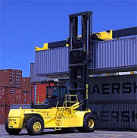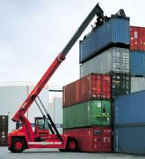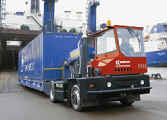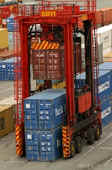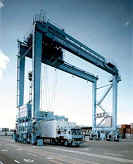Heavy Duty Industrial Pavement Design Guide
The Heavy Duty Industrial Pavement Design Guide has been developed for users of the HIPAVE software. The Guide is a collaborative effort currently involving Dr. Leigh Wardle of Mincad Systems, Ian Rickards (Pioneer Road Services Pty Ltd, Melbourne, Australia), John Lancaster (VicRoads, Australia) and Dr. Susan Tighe (Dept. Civil Engineering, University of Waterloo, Canada).
HIPAVE
HIPAVE (Heavy Industrial PAVEment design) is for the mechanistic analysis and design of flexible pavements subjected to the extremely heavy wheel loads associated with freight handling vehicles in industrial facilities, in particular, intermodal container terminals. It conveniently models each combination of vehicle model and container load and combines the damage using the Cumulative Damage Factor concept.
Click here to read more.
The Guide presents best practice in the design of new construction and rehabilitation of industrial pavements. The Guide steers the designer through all necessary design considerations and suggests external sources for research updates.
Download the Guide: Heavy Duty Industrial Pavement Design Guide.
Contact us if you would like to be notified when the Guide is updated. (Not required if you already receive email from us.)
|
|
|
|
||
|
|
|
HIPAVE Referenced in PIANC Guide – Design and Maintenance of Container Terminal Pavements
See this 163 page report: MarCom WG 165 – Design and Maintenance of Container Terminal Pavements (2015).
This report covers these design methods: HIPAVE, British Port Association (BPA) Edition 4 (2007), French LCPC Method (using ALIZE software) and the Sector Standard of the People’s Republic of China – Code for Design and Construction of Pavements Roads and Stockyards in Ports – JTJ 296-96, 1997.
PIANC has Technical Commissions concerned with inland waterways and ports (InCom), coastal and ocean waterways (including ports and harbours) (MarCom), environmental aspects (EnviCom) and sport and pleasure navigation (RecCom).
This report has been produced by an international Working Group convened by the Maritime Navigation Commission (MarCom). Members of the Working Group represent several countries and are acknowledged experts in their profession.
The objective of this report is to provide information and recommendations on good practice. Conformity is not obligatory and engineering judgement should be used in its application, especially in special circumstances. This report should be seen as an expert guidance and state of the art on this particular subject. PIANC is not a certifying body and disclaims all responsibility in case this report should be presented as an official standard and/or as a certification.
Conference Papers
We have recently published three papers that outline the design philosophy of the Guide:
Wardle , L., Rickards, I. and Lancaster, J. (2006). HIPAVE – A Tool To Assist In The Mechanistic Empirical Design Of Heavy Duty Industrial Flexible Pavements. 10th International Conference on Asphalt Pavements (ISAP), Quebec, Canada, August. 12-17.
Wardle, L. J., Rickards, I. and Hudson, K. (2005). HIPAVE A Mechanistic Design Tool for Heavy-Duty Industrial Pavements. Proc. AAPA Pavements Industry Conf., Surfers Paradise, Australia.
Wardle, L. J. and Oldfield, D. (2005). HIPAVE A Mechanistic Design Tool for Flexible Port Pavements. Proc. 2005 Coasts and Ports Australasian Conference, Adelaide, South Australia 21-23 September 2005.
Make sure you use appropriate Performance Data
We have recently published a paper that describes why performance data developed for highway pavements is not appropriate for heavy loadings such as airports and container terminals and can lead to grossly under-designed pavements.
Layered Elastic Design Of Heavy Duty And Industrial Pavements – Rodway, B. and Wardle, L.J. (1998)

